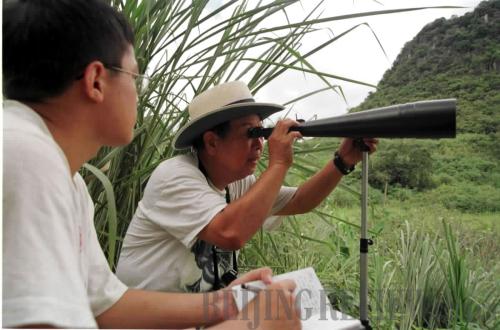|
Panda's father
 |
|
FIELD STUDY: Professor Pan Wenshi (right) observes langurs in Guangxi Zhuang Autonomous Region (XINHUA) |
The 72-year-old Pan is an internationally renowned biologist. He is known as the "panda's father" because before devoting himself to saving the white-headed langurs, he spent 16 years studying pandas in their natural habitats. He traversed the Qinling Mountains, which are crisscrossed by 107 rivers and 108 ridges. He defied hostile conditions such as freezing temperatures to gather valuable data on the panda's social structure and breeding behavior in the wild.
In the 1980s, pandas went hungry after their staple food bamboo disappeared. There was a plan to rescue the pandas by raising them in captivity, but Pan wrote a letter to the government to stop the idea because he believed that putting all pandas in captivity would disrupt their social structure and inhibit their reproduction. The best way to protect pandas, he said, was to protect their natural habitat and let them live there unmolested. The massive capture plan was aborted.
Pan found that panda DNA was diverse, and had not deteriorated to the level of close inbreeding. His study showed that the animals' natural birth rate in the wild was not as low as many people had thought, and protecting their habitat while at the same time preventing poaching was critical to their survival. Pan brought his rich experience in panda research and conservation to save Guangxi's langurs.
A conservationist researcher
Over the last 30 years, Pan has spent at least 10 months a year at field research centers. But his efforts to save the langurs have not been restricted to academic research.
"We cannot protect wild animals by only publishing papers," Pan said. "If our research subjects all die, what is the value of our research?"
The natural habitat of langurs in Guangxi is one of the poorest areas in China. Langurs feed on the leaves, roots, stems and fruits of wild plants growing in the area between stone hills and farmlands. Langurs and local villages share the same ecological area and compete with each other for natural resources.
Farmers depend on firewood for fuel and land to grow food. Pan realized that to protect langur habitat, local farmers must be helped to feed themselves and find affordable alternative energy.
He has won an environmental award from Ford Motor Co. He donated the money and raised additional funds to build biogas digesters. When farmers realized that methane gas from animal waste and leaves could produce cooking fuel, they stopped chopping down trees for fuel. Villagers began gathering cow manure and other waste to produce biogas, and the villages got cleaner.
Rural residents once shared water sources with animals, which often made people sick. Pan lobbied the local government to install a clean water system. Now villagers have clean drinking water. Pan also raised funds to build a hospital in the area.
Villagers repaid Pan's efforts by protecting langurs. They began stopping outsiders from poaching the langurs and treated sick or injured ones. Pan has raised local awareness to protect the environment and live in harmony with nature.
Pan also helped the community establish a public ecological park. A Guangxi Forest Bureau officer said the park was set up so more people could get a chance to learn about langurs and how to protect them. Visitors are able to watch langurs from a distance, and the daily number of visitors is restricted so that langurs are not disturbed, the officer said.
"It's a model of what can be done in hot-spot areas that have been devastated by development," said Russell Mittermeier, President of Conservation International. "Pan has combined all the elements—protection, research and good relations with the local community. He's really turned the langur into a flagship for the region."
Thanks to the efforts of various stakeholders, the langur population has started to rebound. They are now spread over a broader area, said Pan. Today, when farmers work in their fields, langurs may be watching quietly from somewhere not far off. | 